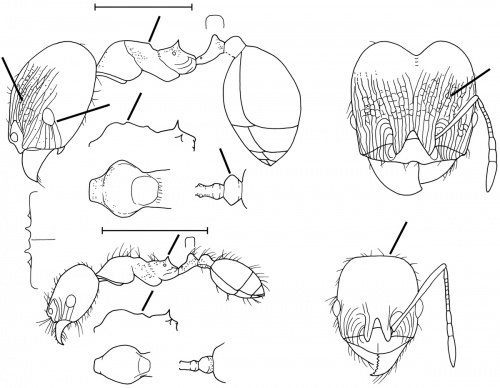Pheidole carapunco
| Pheidole carapunco | |
|---|---|
| Scientific classification | |
| Kingdom: | Animalia |
| Phylum: | Arthropoda |
| Class: | Insecta |
| Order: | Hymenoptera |
| Family: | Formicidae |
| Subfamily: | Myrmicinae |
| Tribe: | Attini |
| Genus: | Pheidole |
| Species: | P. carapunco |
| Binomial name | |
| Pheidole carapunco Kusnezov, 1952 | |
The biology of this species is unknown.
Identification
See the description in the nomenclature section.
Keys including this Species
Distribution
A temperate montane Argentine species, known only from Salta and Tucumán. (Wilson 2003)
Latitudinal Distribution Pattern
Latitudinal Range: -26.808285° to -26.808285°.
| North Temperate |
North Subtropical |
Tropical | South Subtropical |
South Temperate |
- Source: AntMaps
Distribution based on Regional Taxon Lists
Neotropical Region: Argentina (type locality).
Distribution based on AntMaps
Distribution based on AntWeb specimens
Check data from AntWeb
Countries Occupied
| Number of countries occupied by this species based on AntWiki Regional Taxon Lists. In general, fewer countries occupied indicates a narrower range, while more countries indicates a more widespread species. |

|
Estimated Abundance
| Relative abundance based on number of AntMaps records per species (this species within the purple bar). Fewer records (to the left) indicates a less abundant/encountered species while more records (to the right) indicates more abundant/encountered species. |

|
Biology
Castes
Nomenclature
The following information is derived from Barry Bolton's Online Catalogue of the Ants of the World.
- carapunco. Pheidole carapunco Kusnezov, 1952b: 82 (s.w.q.m.) ARGENTINA. See also: Wilson, 2003: 389.
Unless otherwise noted the text for the remainder of this section is reported from the publication that includes the original description.
Description
From Wilson (2003): Placed tentatively in the flavens group, but with a habitus intermediate to that of the tristis group.
Major: large (for flavens group); carinulae originating on anterior margin of the eye spread forward from one another in traveling to the genal border; a broad, continuous band of rugoreticulum extends from the inner margin of one eye to that of the other across the vertex. The true characteristics of this species will remain problematic until fresh material is collected.
MEASUREMENTS (mm) Syntype major: HW 1.20, HL 1.24, SL 0.62, EL 0.20, PW 0.54. Minor: HW 0.52, HL 0.60, SL 0.48, EL 0.10, PW 0.14.
COLOR Major: concolorous medium reddish brown. Minor: head and gaster yellowish brown; mesosoma, waist, and appendages dark yellow.
Figure. Upper: syntype, major (a composite from 2 damaged specimens; Carapunco, between Tafi de Valle and Infiernillos, Tucumán, 2600 m, N. Kusnezov). Lower: minor (El Rey, Salta, 2200 m, N. Kusnezov). The major syntype is partly decayed, and may have lost most of its pilosity. The El Rey minor is undecayed, and the pilosity appears intact. Scale bars = 1 mm.
Type Material
Carapunco, between Tafi de Valle and Infiernillos, Tucumán, 2600 m, N. Kusnezov. Fundacion e Instituto Miguel Lillo and Museum of Comparative Zoology
Etymology
Named after the type locality. (Wilson 2003)
References
- Kusnezov, N. 1952d [1951]. El género Pheidole en la Argentina (Hymenoptera, Formicidae). Acta Zool. Lilloana 12: 5-88 (page 82, soldier, worker, queen, male described)
- Wilson, E. O. 2003. Pheidole in the New World: A dominant, hyperdiverse ant genus. Harvard University Press, Cambridge, MA. (page 389, fig. major, minor described)
References based on Global Ant Biodiversity Informatics
- Kusnezov N. 1978. Hormigas argentinas: clave para su identificación. Miscelánea. Instituto Miguel Lillo 61:1-147 + 28 pl.
